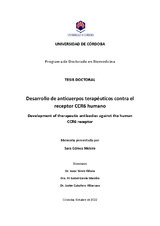Desarrollo de anticuerpos terapéuticos contra el receptor CCR6 humano
Development of therapeutic antibodies against the human CCR6 receptor
Autor
Gómez-Melero, Sara
Director/es
Túnez, IsaacGarcía-Maceira, Fé I.
Caballero-Villarraso, Javier
Editor
Universidad de Córdoba, UCOPressFecha
2022Materia
Anticuerpos monoclonalesReceptor CC de quimioquinas 6 humano
CCR6h
CCL20
Dianas terapéuticas
Biología molecular
METS:
Mostrar el registro METSPREMIS:
Mostrar el registro PREMISMetadatos
Mostrar el registro completo del ítemResumen
El receptor CC de quimioquinas 6 humano (CCR6h) es una diana con un gran potencial terapéutico ya que cuando se une a su ligando, CCL20, se produce una red de señalización que está implicada en procesos relacionados con un gran número de enfermedades como cáncer, psoriasis, artritis reumatoide, esclerosis múltiple o infección por VIH. Las células Th17 expresan CCR6 y citoquinas inflamatorias, incluyendo IL-17, que están implicadas en la propagación de respuestas inmunes inflamatorias. Un anticuerpo antagonista de CCR6h sería un tratamiento potencial para pacientes con enfermedades relacionadas con el eje CCR6h-CCL20. Por ello, el objetivo de este estudio fue desarrollar un anticuerpo monoclonal antagonista dirigido hacia el receptor CCR6h. Se generaron los anticuerpos monoclonales inmunizando ratones BALB/c con células que sobre-expresaban el receptor CCR6h. Se probó la especificidad de la unión de los anticuerpos al receptor por citometría de flujo y se obtuvieron clones mediante el método de dilución limitante. De este modo, se aisló el anticuerpo monoclonal anti- CCR6h, denominado 1C6. Mediante ELISA y citometría de flujo, se determinó contra qué epítopo mapea el anticuerpo obtenido, resultando ser un anticuerpo de unión al dominio amino terminal del CCR6h. La capacidad del anticuerpo 1C6 para neutralizar la señalización a través del receptor CCR6h fue evaluada a través de las vías dependiente e independiente de proteína G, mediante ensayos de flujo de calcio y de reclutamiento de β-arrestina, respectivamente. Se determinó que el anticuerpo 1C6 es capaz de bloquear la señalización mediada por el reclutamiento de β-arrestina con una IC50 de 10,23 nM, sin embrago, no inhibe la señalización por flujo de calcio. Además, se realizaron ensayos de quimiotaxis en los que se demostró que el anticuerpo 1C6 reduce la migración de células que expresan CCR6h hacia su ligando CCL20. Finalmente, se determinó a través de ELISA que la producción de CCL20 no se ve afectada por el anticuerpo 1C6, pero sí se produce una reducción de la producción de IL-17A por células Th17. Esta disminución de la producción de IL-17 fue confirmada en el análisis de la expresión de IL-17 en células Th17 mediante RT-qPCR. En conclusión, en el presente trabajo se aplicó la inmunización con células enteras para obtener con éxito un anticuerpo específico y selectivo del receptor CCR6h. Por lo tanto, este método de inmunización proporciona un enfoque efectivo para obtener anticuerpos terapéuticos dirigidos hacia GPCRs. El anticuerpo obtenido, llamado 1C6, es capaz de neutralizar la señalización de receptor, reducir la migración de células CCR6+ y la expresión de IL-17. Estos resultados indican que el anticuerpo 1C6 posee características que lo convierten en una atractiva herramienta terapéutica en el tratamiento de enfermedades relacionadas con el receptor CCR6h. The human CC chemokine receptor 6 (hCCR6) is a target with a great therapeutic potential, since when it binds to its ligand, CCL20, a signaling network is produced that is involved in processes related to a large number of diseases such as cancer, psoriasis, rheumatoid arthritis, multiple sclerosis or HIV infection. Th17 cells express CCR6 and inflammatory cytokines, including IL-17, which are involved in the spread of inflammatory immune responses. An antagonist antibody against CCR6h would be a potential treatment for patients with diseases related to the CCR6h-CCL20 axis. The aim of this study was to develop an antagonist monoclonal antibody directed at the CCR6h receptor. Monoclonal antibodies were generated by immunizing BALB/c mice with cells that overexpressed CCR6h. The specificity of antibody binding to the CCR6h receptor was tested by flow cytometry and clones were obtained by the limiting dilution method. Thus, the anti-CCR6h monoclonal antibody, called 1C6, was isolated. Epitope binding it was determined using ELISA and flow cytometry, and resulted that the obtained antibody binds to the amino terminal domain of the CCR6h receptor. The ability of the 1C6 antibody to neutralize signaling through the CCR6h receptor was evaluated through the G-protein-dependent and independent pathways, using calcium flux assays and β-arrestin recruitment, respectively. It was determined that the antibody 1C6 is able to block the signaling mediated by the recruitment of β-arrestin with an IC50 of 10.23 nM, however, it is unable to inhibit calcium flux signaling. In addition, chemotaxis assays were performed and showed that the 1C6 antibody reduces the migration of cells expressing CCR6h to their CCL20 ligand. Finally, it was determined through ELISA that the production of CCL20 is not affected by the antibody 1C6, but there is a reduction in the production of IL-17A by Th17 cells. This decrease in IL-17 production was confirmed by analyzing IL-17 expression in Th17 cells using RT-qPCR. In conclusion, in the present study whole cell immunization was applied to obtain a specific and selective antibody against CCR6h. Therefore, this method of immunization provides an effective approach to obtain potential therapeutic antibodies directed towards GPCRs. The obtained antibody, called 1C6, is able to neutralize receptor signaling, reduces the migration of CCR6+ cells and the expression of IL-17. These results indicate that the 1C6 antibody has characteristics that make it an attractive therapeutic tool in the treatment of diseases related to the CCR6h receptor.

